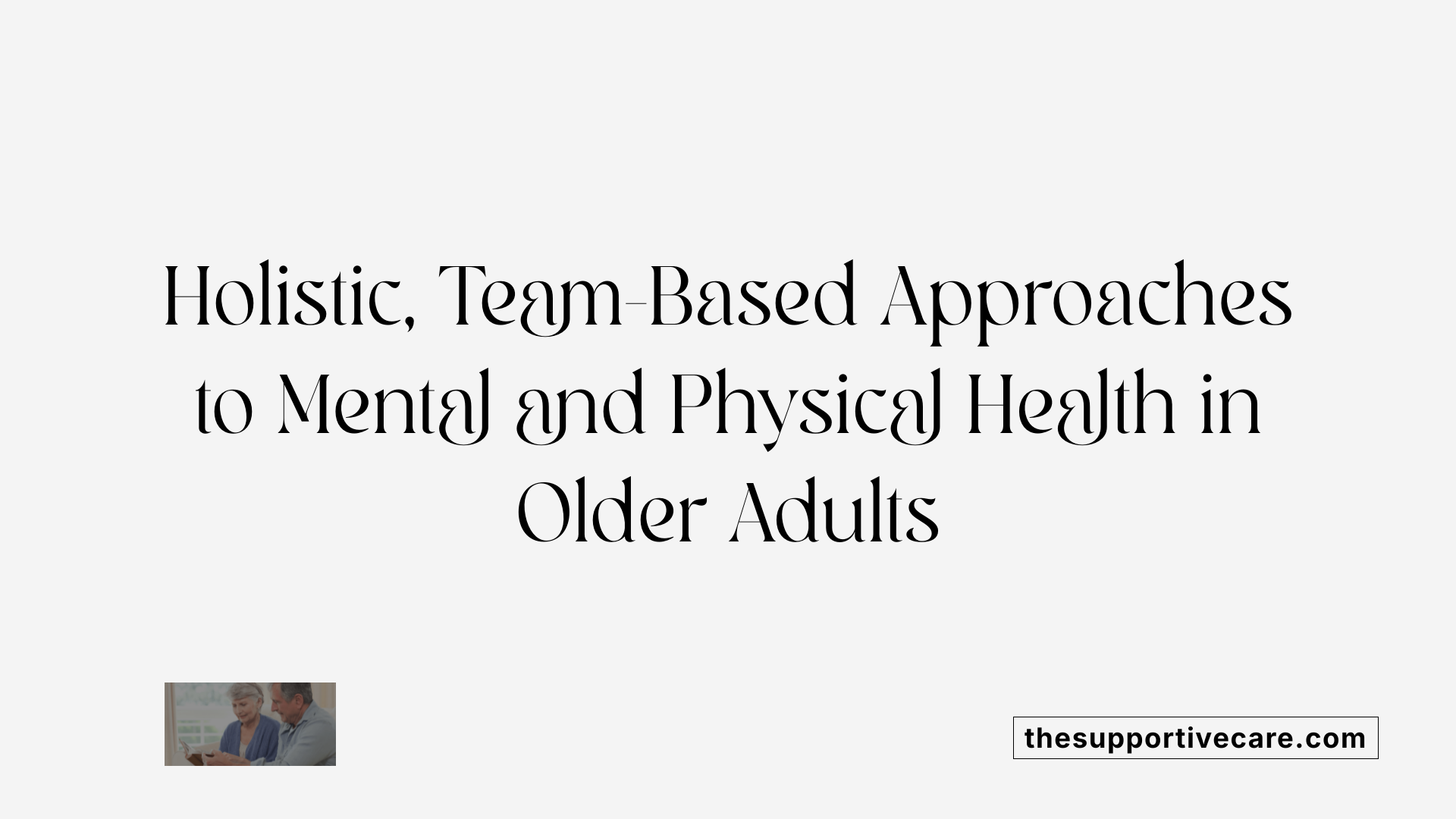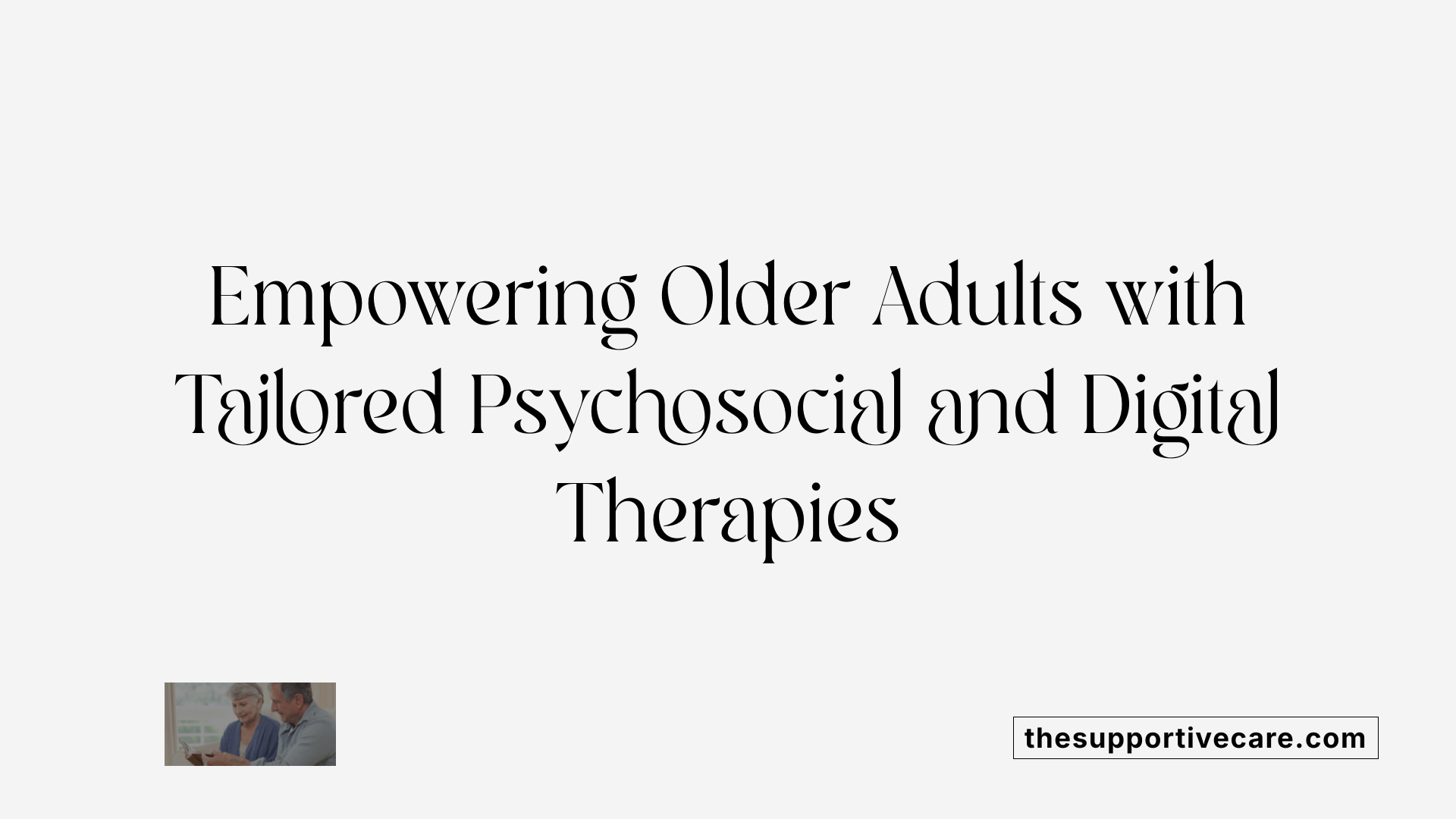The Challenge of Mental Health in an Aging Population
As the global population ages, the prevalence of mental health disorders and substance use among older adults with chronic illnesses presents distinct challenges. The intersection of aging, physical health conditions, and mental well-being demands comprehensive, integrated treatment approaches. Understanding these complexities is essential for improving quality of life and care outcomes for seniors.
Understanding Mental Health and Substance Use Disorders in Seniors
How common are mental health and substance use disorders among older adults?
Mental health issues affect about 20% of adults aged 65 and older, with conditions like depression, anxiety, and substance use disorders being prevalent. Approximately 5.5% to 5.9% experience major depressive episodes annually. Substance use disorder affects roughly 1 in 11 seniors, with alcohol misuse being the most common, followed by cannabis use, both rising, especially among older women. Despite lower overall rates compared to younger populations, the consequences can be severe due to age-related physiological changes.
How do chronic illnesses impact mental health in seniors?
Older adults often face coexisting physical illnesses such as diabetes, hypertension, or disabilities that increase the risk of depression and anxiety. Chronic conditions complicate treatment and can worsen mental health outcomes if not managed collaboratively. Cognitive decline and neurocognitive disorders like Alzheimer's disease further complicate this picture, affecting memory and executive functions while increasing disability.
What mental health conditions are common among seniors?
Common conditions include late-life depression, anxiety disorders, neurocognitive disorders (such as Alzheimer's), and substance use disorders. Late-life depression affects up to 15% of seniors and frequently presents with somatic symptoms and functional decline. Neurocognitive disorders contribute significantly to disability, with advances in biomarkers aiding early diagnosis. Substance misuse often goes unrecognized, with risks including falls, medication interactions, and cognitive decline.
What comprehensive treatment services are available for substance abuse and mental health disorders?
Effective treatment involves integrated, multidisciplinary care that addresses both mental health and substance use disorders simultaneously. This includes detoxification; evidence-based therapies like cognitive behavioral therapy (CBT) and motivational interviewing; medication-assisted treatments such as methadone, buprenorphine, and naltrexone for opioid use disorder; and psychosocial supports. Collaborative care models connect primary care, mental health, and social services to provide individualized care plans.
Barriers like stigma, transportation issues, and workforce shortages often impede access, but telehealth and community outreach have improved availability. Ongoing support through case management, peer programs, and relapse prevention is critical for long-term recovery in older adults. Ensuring age-friendly, coordinated services that address social determinants of health enhances effectiveness and promotes resilience.
| Aspect | Details | Importance |
|---|---|---|
| Prevalence | 20% have mental health concerns; 1 in 11 have substance use issues | Highlights the widespread need for targeted interventions |
| Impact of Chronic Illness | Increases risk and complicates treatment | Necessitates integrated physical and mental health care |
| Common Conditions | Depression, anxiety, dementia, and substance misuse | Guides screening and treatment priorities |
| Treatment Approaches | Multidisciplinary care with therapies, medication, and social support | Offers effective, personalized management |
| Barriers and Solutions | Stigma, transportation; improved by telehealth and community programs | Essential to improve access and adherence |
The Importance of Early Detection and Accurate Diagnosis
What Screening Tools Are Used for Mental Health in Seniors?
Early detection of mental health issues in older adults is crucial for timely intervention and better outcomes. Commonly used screening tools include the Geriatric Depression Scale (GDS) and the Patient Health Questionnaire-9 (PHQ-9) for depression, the Mini-Mental State Examination (MMSE) and Montreal Cognitive Assessment (MoCA) for cognitive impairment. These brief, standardized tools help clinicians identify depression, cognitive decline, and other mental health concerns in seniors efficiently.
How Are Neurocognitive Disorders Diagnosed?
Diagnosis of neurocognitive disorders like Alzheimer’s disease and other dementias involves comprehensive assessment including clinical evaluation of memory, executive function, and daily living activities. Cognitive aging does show gradual declines especially in episodic memory; however, significant impairments warrant further evaluation. Early diagnosis is facilitated by collaborative care models that incorporate both pharmacological and non-pharmacological strategies for management.
What Is the Role of Biomarkers in Dementia Diagnosis?
Advancements in biomarkers have transformed dementia diagnosis by providing objective measures of disease pathology. Biomarkers such as amyloid and tau imaging, cerebrospinal fluid (CSF) analysis, and emerging blood-based markers improve diagnostic precision. These markers enable earlier identification of Alzheimer’s disease and help differentiate it from other neurocognitive disorders, guiding treatment decisions and eligibility for emerging disease-modifying therapies like aducanumab. Incorporating biomarkers supports personalized care and may improve prognosis through timely intervention.
Integrated and Multidisciplinary Care Models

Multidisciplinary Team Composition
Effective care for older adults with mental health and substance use disorders relies on multidisciplinary teams composed of psychiatrists, psychologists, addiction counselors, social workers, primary care physicians, and community health workers. This diverse team ensures holistic approaches addressing psychiatric, physical, and social needs simultaneously. Specialized roles enable comprehensive assessment, coordinated clinical management, outreach services, and personalized care planning.
Integration of Mental, Physical, and Social Health Services
Integrated care models combine mental health, addiction treatment, and physical healthcare within single, coordinated frameworks. This approach facilitates seamless communication across providers, addresses medical comorbidities common in older adults, and incorporates social determinants such as isolation and stigma into treatment plans. Embedding behavioral health services into primary care settings and including outreach to home and community services reduce barriers like transportation and stigma.
Collaborative Care Benefits
Collaborative care offers significant advantages for managing co-occurring disorders in older adults. Combining pharmacological treatments, evidence-based psychotherapies (e.g., cognitive behavioral therapy, motivational interviewing), and tailored social interventions enhances engagement and treatment adherence. Integrated programs improve detection through routine screening and foster holistic recovery by addressing mental symptoms and addiction concurrently. Research demonstrates these models reduce hospitalizations, improve quality of life, and leverage strengths such as resilience and social support to bolster outcomes.
How Do Treatment Programs Address Both Addiction and Co-Occurring Mental Health Challenges Simultaneously?
Treatment programs utilize integrated care strategies that blend behavioral therapies, medication-assisted treatment, and personalized plans coordinated by multidisciplinary teams. Services may be co-located or fully integrated to ensure patients receive accessible, comprehensive care. Routine screening identifies both mental health and substance use disorders, facilitating early intervention. Evidence from these models shows improved patient motivation, reduced substance use, enhanced symptom control, and decreased healthcare utilization. The holistic philosophy, such as SAMHSA’s 'no wrong door' approach, ensures that older adults receive support for all overlapping conditions under one umbrella, making recovery more achievable.
Addressing Social Determinants and Reducing Stigma

How Do Stigma and Ageism Impact Treatment for Older Adults?
Stigma and ageism significantly hinder access to and effectiveness of mental health treatment in older adults. Many face negative stereotypes that their mental health struggles are just ‘‘part of aging,’’ which leads to underdiagnosis and undertreatment. This discrimination can discourage older adults from seeking help, perpetuating cycles of isolation and symptom worsening.
What Role Do Social Isolation and Loneliness Play in Mental Health?
Social isolation and loneliness are critical social determinants that negatively affect mental wellness. These factors increase vulnerability to depression, anxiety, and cognitive decline. Older adults often experience loss of social networks due to retirement, bereavement, or mobility issues, which intensifies feelings of loneliness and exacerbates mental health conditions.
How Can Community Engagement and Resilience Promotion Improve Outcomes?
Promoting community involvement and building psychosocial strengths like resilience and wisdom can counterbalance stigma and social isolation. Engagement in social groups and activities fosters a sense of purpose and belonging, which supports mental well-being. Resilience, the ability to adapt to changes and stressors, shields against mental health deterioration and enables successful aging.
Addressing social determinants requires multifaceted efforts: reducing stigma through education, improving social connectedness, and enhancing resilience through community resources. This holistic approach is essential to improve prevention, treatment, and quality of life for older adults with mental health needs.
Promoting Positive Psychosocial Traits to Enhance Mental Health

How Do Resilience, Wisdom, and Community Involvement Benefit Older Adults?
Resilience, wisdom, and active community involvement are powerful contributors to better mental health outcomes in older adults. These traits help seniors cope with life’s challenges, reduce feelings of loneliness, and create a sense of purpose and connection. Engaging in community activities fosters social ties, which can buffer against depression and anxiety while promoting a sense of belonging.
What Psychosocial Protective Factors Support Well-being in Seniors?
Psychosocial protective factors such as optimism, meaningful relationships, and the ability to find purpose in daily life enhance mental well-being. These traits improve emotional regulation, help maintain cognitive function, and encourage healthy behaviors that collectively reduce mental health decline. Developing these protections promotes psychological resilience, aiding older adults in adapting to new circumstances or health issues.
In What Ways Can Positive Aging Elements Counteract Ageism and Stigma?
Promoting positive elements of aging—like accumulated wisdom, community engagement, and life meaning—challenges stereotypes of decline and incapacity. By emphasizing strengths rather than deficits, these traits combat ageism and reduce stigma surrounding mental illness in seniors. Celebrating these qualities fosters respect and supports more inclusive, empowering approaches to elder mental health care.
| Psychosocial Trait | Benefit for Mental Health | How It Counters Ageism and Stigma |
|---|---|---|
| Resilience | Enhances coping with stress and adversity | Shows older adults as capable and adaptive |
| Wisdom | Improves decision-making and emotional understanding | Highlights lifelong growth and experience |
| Community Involvement | Provides social support and a sense of belonging | Demonstrates active societal contribution |
Fostering these traits through programs and support can serve as a powerful strategy to improve mental health outcomes and create age-friendly communities that respect and empower older adults.
Cognitive Aging and Neurocognitive Disorders: Challenges and Advances
Cognitive decline and variability in aging
Cognitive aging typically involves a gradual decline in episodic memory and executive function. However, individual experiences vary widely, with some older adults showing stable or even improved cognitive abilities, especially in areas like wisdom and prosocial behaviors. This variability underscores the need to tailor assessments and interventions to individual cognitive profiles rather than applying a one-size-fits-all approach.
Alzheimer’s disease and other dementias
Neurocognitive disorders, especially Alzheimer’s disease and related dementias, are significant contributors to disability in older adults. These conditions commonly overlap with mood and behavioral symptoms, complicating diagnosis and treatment. Prevalence rates increase markedly with age, making these disorders a major public health concern as the global population ages.
Advances in diagnostics and emerging treatments
Recent advances in diagnostic technology have substantially improved early detection of neurocognitive disorders. Biomarkers such as amyloid and tau imaging, as well as cerebrospinal fluid and blood markers, enable more precise diagnosis. Early detection is critical as it allows timely interventions that combine pharmacological and non-pharmacological strategies. Emerging treatments include disease-modifying agents like aducanumab, which target underlying disease pathology, although debate continues about their overall efficacy.
Prevention efforts integrate management of vascular risk factors, physical activity, cognitive training, and dietary interventions. The Finnish Geriatric Intervention Study to Prevent Cognitive Impairment and Disability (FINGER) demonstrated promising results using a multidomain approach. Collaborative care models that blend medication, psychosocial support, and community resources are proving effective in managing neurocognitive disorders and enhancing quality of life in older adults.
Managing Late-Life Depression and Anxiety in Chronic Illness
What is the prevalence and impact of late-life depression?
Late-life depression affects up to 15% of older adults and presents a significant concern, especially among those with chronic illnesses such as diabetes and hypertension. The 12-month prevalence of major depressive episodes (MDE) in this population ranges from about 5.5% in developed countries to 5.9% in developing countries. Untreated depression and anxiety can result in increased functional impairments, including cognitive difficulties, somatic symptoms, and a higher risk of suicide, with men showing notably higher rates than women. These mental health issues often compound the burden of physical illnesses and contribute to poorer overall health outcomes.
What are effective staged treatment approaches for late-life depression?
Treatment for late-life depression typically involves staged approaches combining pharmacotherapy and psychotherapy. Medication management may include antidepressants tailored to older adults, while psychotherapeutic interventions like short-term cognitive-behavioral therapy (CBT) focus on modifying negative thought patterns and behaviors. Integrated care models that blend mental health treatment into primary care settings have shown promise in improving outcomes. Such models use measurement-based practices and involve coordinated management of both mental and physical health conditions to address the complexities in older adults with chronic illness.
How do psychosocial interventions and community support improve outcomes?
Psychosocial interventions are vital in managing depression and anxiety among older adults, especially when coupled with chronic conditions. Community engagement and social support reduce loneliness and social isolation, which are known risk factors for mental health deterioration. Programs promoting resilience, wisdom, and meaningful involvement in community life enhance well-being and can serve as protective factors. Supportive services like case management and peer support facilitate treatment adherence and social connectedness, contributing to improved functioning and quality of life for older adults facing mental health challenges alongside chronic illness.
Substance Use Disorders Among Older Adults: Identification and Treatment
What forms of addiction are typically addressed in comprehensive treatment services?
Comprehensive treatment services for older adults cover a wide spectrum of substance use disorders (SUD), primarily involving substances such as alcohol, opioids, stimulants, nicotine, marijuana, sedatives, hallucinogens, and inhalants. Additionally, behavioral addictions like gambling, gaming, and internet use may also be addressed. Addiction is treated as a chronic brain disorder requiring a multidisciplinary approach that includes medication, psychotherapy, and support groups to tackle both physical dependence and psychological factors.
Prevalence and risk factors
In 2022, approximately 1 in 11 adults over 60 had a substance use disorder, with prevalence expected to rise alongside the aging population. Alcohol remains the most common substance misused, followed by cannabis, with increasing rates of binge drinking notably among older women. Age-related physiological changes such as reduced liver function and muscle mass alter drug metabolism, increasing risks like falls and cognitive decline. Risk factors for initiation or escalation of use in older adults include bereavement, social isolation, financial stress, forced retirement, and prior substance use history.
Screening and tailored treatment options
Routine screening for substance misuse is vital because symptoms may be subtle, mistaken for other health issues, or hidden by stigma. Mental health professionals often use validated tools tailored to older adults for early identification. Effective treatment respects social norms and autonomy, incorporates family support when appropriate, and adapts evidence-based behavioral therapies such as cognitive behavioral therapy (CBT) and motivational interviewing (MI). Screening and brief interventions help tailor care to individual needs, ensuring better engagement and outcomes.
Medication-assisted therapies and behavioral interventions
FDA-approved medications like methadone, buprenorphine, and naltrexone are critical for managing opioid use disorder in older adults. These medications reduce cravings and withdrawal symptoms and are most effective when combined with behavioral health interventions. Psychosocial treatments such as Cognitive Behavioral Social Skills Training (CBSST), Functional Adaptation Skills Training (FAST), and Motivational Interviewing are effective in improving functioning and social engagement. Integrated care models that combine mental health and substance use treatment with primary care foster improved access, adherence, and holistic management.
Older adults can achieve recovery outcomes comparable to younger populations when interventions account for age-related changes and comorbidities. Addressing social determinants, stigma reduction, and delivering age-friendly services strengthen treatment success.
| Topic | Details | Importance |
|---|---|---|
| Types of Addiction | Alcohol, opioids, stimulants, nicotine, cannabis, behavioral addictions | Comprehensive treatment ensures all aspects of addiction are addressed |
| Risk Factors | Bereavement, isolation, retirement, prior use history | Identifying risk factors allows for targeted prevention and early intervention |
| Screening Tools | Routine assessments, specialized tools for older adults | Early detection improves treatment outcomes |
| Medications | Methadone, buprenorphine, naltrexone | Critical for opioid use disorder management |
| Behavioral Therapies | CBT, motivational interviewing, CBSST, FAST | Enhances coping skills, social functioning, and relapse prevention |
| Integrated Care Models | Combining mental health, addiction treatment, and primary care | Facilitates holistic, coordinated treatment improving accessibility and adherence |
Barriers and Solutions to Accessing Care for Seniors with Substance Use Issues
Regulatory and Logistical Challenges
Older adults seeking treatment for substance use disorders (SUD) face several regulatory and logistical hurdles. Federal rules often require in-person evaluations and frequent medication dosing, which can be particularly difficult for seniors with mobility limitations. Additionally, opioid treatment programs (OTPs) typically operate separately from primary care settings, complicating integrated care and creating fragmented treatment experiences. Post-acute and long-term care facilities frequently exclude individuals with SUD due to regulatory restrictions and stigmatization, limiting access to essential medication-assisted treatments (MAT) with methadone, buprenorphine, and naltrexone.
Impact of Stigma and Provider Training
Stigma surrounding substance use in older adults remains a critical barrier. Many symptoms are misattributed to aging or other medical conditions, leading to underrecognition and undertreatment. Provider shortages and insufficient training in geriatric addiction medicine further exacerbate these challenges, reducing opportunities for appropriate screening and intervention. This contributes to a cycle where older adults often go untreated despite the availability of effective therapies.
Role of Telemedicine and Age-Friendly Care Principles
The COVID-19 pandemic prompted temporary regulatory relaxations allowing telemedicine and home delivery for SUD treatments, substantially improving access for seniors. Permanently adopting these measures, alongside incorporating the 4Ms framework—Matters Most, Medication, Mentation, and Mobility—can make treatment programs more age-friendly. Integrating mental health and addiction services within primary care, supported by multidisciplinary teams, can better address the complex needs of aging adults. Such approaches facilitate comprehensive, coordinated care that reduces barriers and promotes sustainable recovery.
Psychosocial Interventions and Digital Therapies for Severe Mental Illness

What are evidence-based psychosocial programs for older adults with severe mental illness?
Several tailored psychosocial interventions effectively support older adults with serious mental illness (SMI). These include:
- Cognitive Behavioral Social Skills Training (CBSST): Combines cognitive behavioral therapy with social skills training to improve everyday functioning and counteract negative thought patterns. Designed with adaptations for age-related cognitive challenges.
- Functional Adaptation Skills Training (FAST): Focuses on enhancing independence in daily living skills such as communication, medication management, and financial tasks. FAST also recognizes cultural needs, especially for Latino populations.
- Helping Older People Experience Success (HOPES): Aims to bolster social skills, community participation, and health management, with measurable improvements in quality of life and independent living abilities.
- Integrated Illness Management and Recovery (I-IMR): Targets both psychiatric symptoms and chronic medical conditions like diabetes and COPD, empowering patients to manage their overall health.
How are digital and remote therapies utilized for this population?
Digital and remote therapeutic approaches have become increasingly important, particularly for enhancing accessibility and continuity of care. These therapies include:
- Remote delivery of CBT and social skills training through telehealth platforms.
- Digital apps designed to support medication management and promote engagement in cognitive and behavioral activities.
- Virtual peer support groups and remote case management, reducing barriers related to mobility or geographic isolation.
How do these interventions improve social engagement and functioning?
Psychosocial programs and digital therapies work together to:
- Enhance motivation and confidence for social interaction.
- Build and maintain practical daily living skills essential for independent community living.
- Reduce feelings of isolation by fostering connections through group activities and peer support.
- Support cognitive functions crucial for managing social and personal responsibilities.
Together, these diverse interventions provide a holistic approach, addressing mental, physical, and social aspects to improve the overall well-being and autonomy of older adults living with serious mental illness.
The Role of Aftercare and Long-Term Support in Recovery
What role does aftercare support play in the recovery process for addiction and mental health treatment?
Aftercare support is crucial for maintaining recovery from addiction and mental health disorders, especially in older adults. It offers continuous emotional, social, and medical assistance that helps prevent relapse after initial treatment phases.
Significance of aftercare in preventing relapse
Sustained recovery depends on ongoing engagement with therapies and community resources. Aftercare addresses underlying psychological challenges, modifying environments to avoid triggers, and manages symptoms that could lead to recurrence. This continuous support diminishes chances of falling back into harmful behaviors.
Supports: therapy, medication management, community programs
Key elements of aftercare include psychotherapy to work through emotional and cognitive difficulties, medication management for controlling cravings or stabilizing mental health, and participation in community-based programs that encourage social connection. Social involvement not only improves well-being but also provides accountability vital for recovery longevity.
Individualized aftercare planning
Successful long-term support requires tailoring plans to meet the unique needs of older adults, considering their physical health, cognitive status, and social circumstances. Collaborative efforts between multidisciplinary teams and the individual ensure that aftercare maximizes effectiveness while respecting personal goals and capabilities.
These ongoing support strategies play a definitive role in helping older adults sustain mental health improvements and reduce risks associated with relapse, ultimately promoting healthier aging and improved quality of life.
Policy Implications and the Future of Gerontological Behavioral Health
Why are systemic policy changes critical for behavioral health care in older adults?
Systemic policy changes are imperative to address the growing complexity of behavioral health needs in the aging population. Older adults often face multimorbidity alongside mental health challenges like depression, dementia, and substance use disorders, yet regulatory and stigma-related barriers impede access to evidence-based treatments in settings such as long-term care and skilled nursing facilities.
Policies must facilitate expanded, age-friendly treatment availability and inclusion of FDA-approved medications for substance use disorders in post-acute care. Moreover, integrating behavioral health into primary and community care settings through multidisciplinary collaborative models requires supportive policy frameworks. This will help overcome fragmentation, reduce drug interaction risks, and promote holistic management adapted to older adults' unique needs.
What drives the increasing demand for age-friendly integrated care?
The rapid growth of the global older adult population — projected to reach two billion by 2050 — coupled with the high prevalence of mental health concerns (around 20% of adults over 65) and rising substance misuse rates (1 in 11 over age 60) drives demand for comprehensive, integrated care.
Age-friendly approaches, such as incorporating the 4Ms (Matters Most, Medication, Mentation, and Mobility) into care programs, are essential to improve treatment outcomes and reduce healthcare disparities. Evidence supports collaborative care models that combine pharmacological treatment, psychosocial interventions, and community engagement to enhance resilience, cognitive function, and overall well-being.
How are research advancements and implementation science shaping future care?
Recent scientific progress—like biomarker-guided diagnosis for dementias, disease-modifying agents (e.g., aducanumab), and cognitive training interventions (like FINGER)—presents new opportunities for early detection and personalized treatments. Additionally, emerging evidence on psychosocial interventions tailored for older adults with serious mental illness highlights the value of adapting therapies to cultural and cognitive needs.
Implementation science frameworks (e.g., RE-AIM) are crucial for translating these advances into routine practice, ensuring fidelity, sustainability, and broad accessibility. These frameworks support organizational support, evaluation, and scaling of effective programs, bridging the gap between research and real-world impact.
Efforts to reduce stigma through education and promote positive aging traits such as resilience and community engagement will complement clinical advances, creating a holistic future for gerontological behavioral health.
Toward Holistic and Compassionate Care for Seniors
Addressing mental health and substance use disorders in older adults with chronic illnesses requires coordinated, compassionate, and comprehensive approaches that integrate medical, psychological, and social dimensions. Advances in diagnostic tools, treatment modalities, and care models offer promising pathways to improve outcomes. Empowering seniors through resilience-building and reducing stigma are equally vital. As demographic shifts continue, it is imperative that policy, healthcare infrastructure, and communities adapt to meet the complex needs of this growing population, ensuring dignity, autonomy, and quality of life in later years.
References
- Mental health care for older adults: recent advances and new ...
- To Care For Older Adults With Substance Use Disorder ...
- Treating substance misuse in older adults
- Treatment of Substance Use Disorders
- Integrating Mental Health Support and Addiction Treatment ...
- Mental health & substance use: Challenges for serving older ...
- Integrated Behavioral Health Care for Older Adults
- Psychosocial Interventions for Older Adults With Serious ...
- The Importance Of Aftercare In Recovery
- Finding Help for Co-Occurring Substance Use and Mental ...




































































































